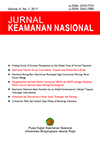Menghidupkan Kembali GBHN: Komparasi GBHN dan RPJPN sebagai Kebijakan Politik Hukum Nasional dalam Bidang Pembangunan
Keywords:
GBHN, Reformation and National DevelopmentAbstract
Political law of development policies in the Reformation era no longer recognized the term National Directives Outline (Garis-Garis Besar Haluan Negara or GBHN). Reformation planners consider the terminology as taboo because of its close association with the New Order (Orde Baru) regime. The Reformation era acknowledges the term Long Term Development Plan (Rencana Pembangunan Jangka Panjang or RPJP) as the political law
of national development policies. In practice, RPJPN is the vision and mission of the elected President and has a limitation of 10 years, exceeding the President’s term of office. Unlike GBHN which is constitutional and bound to be executed regardless of who is leading, RPJP is political and compromising in nature and, therefore fraught with inconsistencies. This article
discusses GBHN and the proposed revival of it as the national development directive.
Downloads

Published
Issue
Section
License
Please read and understand the copyright terms for submissions to this journal.
Copyright Notice
The Jurnal Keamanan Nasional is under the Creative Commons Attribution 4.0 International (CC-BY 4.0) License, according to which:
1) Authors retain copyright and grant the journal the right to first publication, with the work simultaneously licensed under the Creative Commons Attribution (CC-BY 4.0) that allows the sharing of articles published with the acknowledgement of authorship and the initial publication in this journal.
2) The authors are authorized to make additional contracts separately for distribution of the version of the work published in this journal (for example, publication in an institutional repository or as a chapter of the book), as long as there is recognition of authorship and initial publication in this journal.
3) Authors are authorized and encouraged to publish and distribute their work online (for example, in institutional repositories or on their personal pages) at any time before or during the editorial process, as it increases the impact and reference of the published work.












